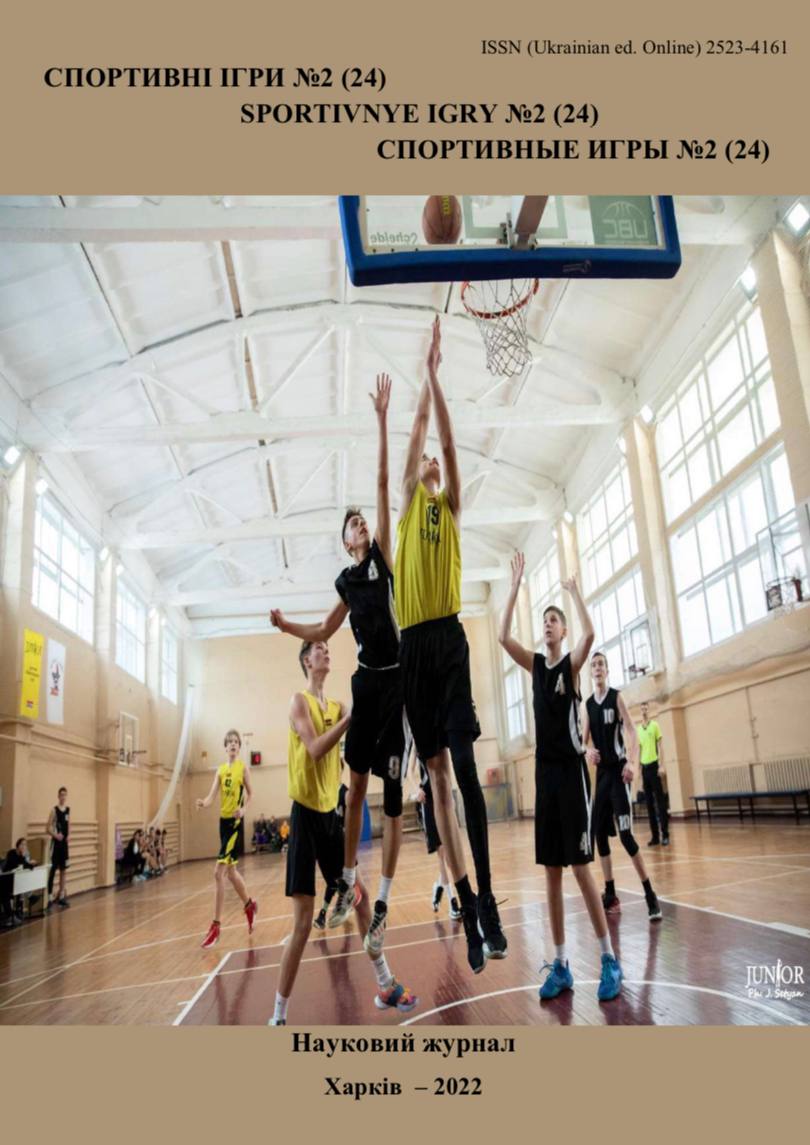Assessment of the parameters of physical development of young football players aged 14-15 years
DOI:
https://doi.org/10.15391/si.2022-2.04Keywords:
body length, body weight, chest circumference, weight-height index, proportionality indexAbstract
Purpose — to establish indicators of the
physical development of young football players aged 14-15. Material and methods: according to
the goal and tasks set, the research program included methods of theoretical analysis and
generalization of scientific and methodological literature, methods of studying anthropometric
characteristics, methods of mathematical processing of results. The study was carried out with the
football players of the team of FC «Arena» Kharkiv – participants in the championship of the CYFL
of Ukraine. The study involved 24 football players aged 14-15. The study was conducted in the
Kharkiv regional medical and sports dispensary. The work was carried out in three stages. At the
first stage, the analysis, study and generalization of scientific and methodological literature were
carried out. At the second stage, a survey of 14-15-year-old football players was carried out. At the
third stage of this study, weight-height indices and proportionality indices were calculated. Results:
the article presents the anthropometric indicators of young football players aged 14-15. It has been
established that 14-15-year-old football players have characteristic overall body dimensions (body
length and weight, chest circumference at rest, on inhalation and exhalation), weight-height indices
(Yarcho-Kraupe, Rohrer and Quetelet indices) and proportionality indices (Erisman and Livy
indices), which were within the age norm for the players of this group. The body weight of the
footballers in this group was 55,8±1,8 kg, body length – 169,1±2,0 cm, circumference of the chest
at rest – 80,8±1,2 cm, circumference of the chest on inspiration – 86,5±1,1 cm, circumference of the
chest on expiration is 78,9±1,2 cm. For football players of 14-15 years old, the average index of the
Yarkho-Kraupe index was 329,0±8,4 g/cm, the Rohrer index – 11,5±0,3 c.u, the Quetelet index –
19,4±0,4 c.u, Erisman index – -3,8±1,1 cm, Livy index – 47,8±0,6%. Conclusions: the data of the
conducted study testify to the differences in morphological parameters, weight-height indices and
proportionality indices among young football players aged 14-15.
References
Антипов, А.В., Губа, В.П. & Тюленьков, С.Ю. (2008). Диагностика и тренировка двигательных способностей в детско-юношескому футболе: научно-методическое пособие. Москва: Советский спорт.
Кузнецов, А.А. (2007). Организационно-методическая структура учебно-тренировочного процесса в футбольной школе. 4 этап (16-17 лет). Москва: Олимпия, Человек.
Лисенчук, Г.А. (2003). Управление подготовкой футболистов. Киев: Олимпийская литература.
Монаков, Г.В. (2007). Подготовка футболистов. Теория и практика. Москва: Советский спорт.
Перевозник, В.И. (2020). Анатомо-фізіологічні особливості розвитку юних футболістів.
Проблеми і перспективи розвитку спортивних ігор і єдиноборств у вищих навчальних закладах, 1, 77-80.
Перевозник, В.И. & Перцухов А.А. (2018). Возрастные и антропометрические показатели футболистов высокой квалификации. Слобожанський науково-спортивний вісник, 6 (68), 65-69. https://doi.org/10.15391/snsv.2018-6.011
Перцухов, А.А. (2010). Оценка функциональной подготовленности футболистов 17-19 лет.
Слобожанський науково-спортивний вісник, 1. 40-42.
Перцухов, А.А. (2011). Взаимосвязь показателей габаритных размеров тела и функциональной подготовленности футболистов 17-19 лет. Физическое воспитание студентов, 4, 64-66.
Перцухов, А.А. & Шаленко, В.В. (2021). Модельні характеристики провідних футболістів різного ігрового амплуа. Слобожанський науково-спортивний вісник, 1 (81), 47-58. https://doi.org/10.15391/snsv.2021-1.007
Платонов, В.Н. (2015). Система подготовки спортсменов в олимпийском спорте. Общая теория и ее практические приложения: учебник (для тренеров). Киев: Олимпийская литература.
Поворознюк, В.В. (2000). Костная ткань у девочек и подростков. Связь с половым и физическим развитием. Вісник Асоціації акушерів-гінекологів України, 2 (7), 88-95.
Прусов, П.К. (2000). Физическая работоспособность и некоторые особенности энергообеспечения юных спортсменов в зависимости от уровня масс ростового соотношения. Педиатрия, 6, 61-64.
Пшибыльский, Б. & Мищенко, В. (2005). Функциональная подготовленность высококвалифицированных футболистов: монография. Киев.
Уилмор, Дж.Х. & Костилл, Д.Л. (1997). Физиология спорта и двигательной активности. Киев: Олимпийская литература.
Шаленко, В.В. & Перцухов, А.А. (2016). Антропометрические показатели футболистов высокой квалификации. Проблемы и перспективы развития спортивных игр и единоборств в высших учебных заведениях. Сборник статей XII международной научной конференции. Харьков, 53-56.
Pelliccia, A., & Maron, B. J. (1999). Physiologic left ventricular cavity dilatation in elite athletes. Annals of internal medicine, 131(7), 546.
Pelliccia, A., Maron, B. J., Spataro, A., Proschan, M. A., & Spirito, P. (1991). The upper limit of physiologic cardiac hypertrophy in highly trained elite athletes. New England Journal of Medicine, 324(5), 295-301.
Pertsukhov, A., Perevoznick, V., Shalenko, V., Zhurid, S., Khudyakova, V. & Koval, S. (2018).
Functional preparedness of football players with different qualifications. Journal of Physical Education and Sport, 18(2), 710-714. DOI:10.7752/jpes.2018.02104
Rowland, T.W. (1989). Oxygen uptake and endurance fitness in children. A developmental perspective. Pediatric Exercise Science, 1, 313-328.
Rowland, T.W. (1991). «Normalizing» maximal oxygen uptake, or the search for the holy grail (per kg). Pediatric Exercise Science, 3, 95-102.













